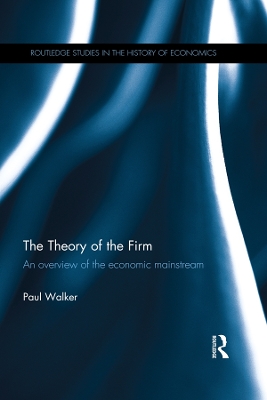Routledge Studies in the History of Economics
3 total works
Firms are a ubiquitous feature of the economic landscape, with much of the activity undertaken within an economy taking place within their boundaries. Given the size of the contribution made by firms to economic activity, employment and growth, having a theoretical understanding of the nature and structure of firms is crucial for understanding how an economy functions.
The Theory of the Firm firstly offers a brief overview of the past, consisting of a concise discussion of the classical view of production, followed by an outline of the development of the neoclassical - or ‘textbook’ - approach to firm level production. Secondly, the ‘present’ of the theory of the firm is discussed in three sections. The first section considers the post-1970 theory of the firm literature per se, while the second section scrutinises the relationship between the three most prominent of the modern sets of theories: the reference point, property rights and transaction cost approaches. The third section looks at the theory of privatisation. The unique aspects of this book includes its discussions of the post-1970 contributions to the theory of the firm; the integration of the theory of the entrepreneur with the theory of the firm; and the theory of privatisation.
This volume offers an intuitive introduction to the theories of the firm as well as simple formal models of the most important contributions to the literature. It also outlines the historical evolution of the traditional and modern theories of the firm. This book is of great interest to those who study history of economic thought, industrial economics and organizational studies.
The theory of the firm did not exist, in any serious manner, until around 1970. Only then did the current theory of the firm literature begin to emerge, based largely upon the work of Ronald Coase and to a lesser degree Frank Knight. It was work by Armen Alchian, Robert Crawford, Harold Demsetz, Michael Jensen, Benjamin Klein, William Meckling and Oliver Williamson, among others, that drove the upswing in interest in the firm among mainstream economists.
This accessible book provides a valuable overview of the ‘prehistory’ of the firm. Spanning an impressive timeline, it delves into Antiquity, the Medieval era, the pre-classical economics period and the 19th and 20th centuries. Next, the book traces the theoretical contributions from pre-classical, classical and neoclassical economics.
It will be illuminating reading for students and researchers of the history of economic thought, industrial organization, microeconomic theory and business history.
Foundations of Organisational Economics: Histories and Theories of the Firm and Production delves into a range of key topics to do with the history of the mainstream approach to the theory of production and the theory of the firm. This includes the frameworks used to analyse production, the division of labour and its application to the firm and the development of the neoclassical model of production.
The first topic explored is the change from a normative approach to a largely positive approach to the analysis of the theory of production, which occurred around the seventeenth century. The next topic is an examination of the relationship (or the lack of a relationship) between the division of labour and the theory of the firm. In the fourth chapter, the focus is on the development of the proto-neoclassical approach to production. Here, the development of the theories of monopoly, oligopoly and perfect competition are discussed, as well as the theory of input utilisation. Chapter 5 looks at Marshall’s idea of the representative firm, which was the main early neoclassical approach to the theory of industry-level production. The penultimate chapter considers the criticisms made of the neoclassical model between 1940 and 1970.
This work is an illuminating reference for students and researchers of the history of economic thought, industrial organisation, microeconomic theory and organisational studies.


